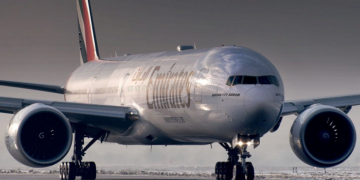The Boeing 777-300ER is the largest and most popular variant of the twin—engine giant family from Boeing. Its dimensions are almost 74 meters long and 65 meters wide.
This aircraft ushered in the era of twin-engined long-haul giants. The first 777-200 was received by United Airlines in 1995. This instance, by the way, is still flying. Due to the huge popularity among airlines, more than 1,500 passenger and cargo variants were sold in total. It can transport a large number of passengers and cargo over long distances, using only two engines.
In 2024, the Boeing 777 will celebrate the 30th anniversary of its first flight, and in 2025, the next generation of mega-twins will appear – the Boeing 777X.
Here are six incredible facts about the Boeing 777.
Its engines are the most powerful in the world
The only engine option on the 777-300ER is the General Electric GE90-115B.
The turbine with blades with a diameter of 3.25 meters is only a few centimeters smaller than the diameter of the Boeing 737 fuselage.
The 777th is the first Boeing controlled via a computer
All levers, joysticks and buttons in the cockpit are connected to computers that control the mechanical parts of the aircraft. This principle is called fly-by-wire.
Airbus was ahead of Boeing in control technology “by wire”, introducing the A320 in the late 1980s.
The next Boeing using the fly-by-wire control principle is the Boeing 787. It uses 777 technology.
The aircraft accommodates more than 500 passengers
The two largest airlines in Japan operated Boeing 777-300, which could accommodate 500 or more passengers — an incredible number for a twin-engine single-deck aircraft.
All Nippon Airways operates 777-300 domestically. It accommodates 514 passengers: 21 in premium class and 419 in economy class. Before the “retirement” in the era of the pandemic, Japan Airlines 777-300 aircraft carried 500 passengers: 78 in business class and 422 in economy.
At one time, ANA operated a fleet of Boeing 747-400, accommodating 567 passengers. But this plane has twice as many engines — four.
The 777-300ER has the same fuselage as the 777-300, but it has a completely new wing, an additional fuel reserve and a different take-off and landing weight. Together, all this leads to a more productive option.


























